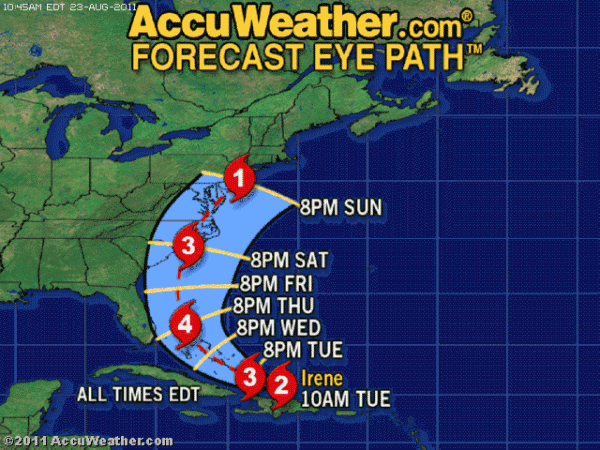Prepare Your Chapter for Hurricane Irene

 INDIANAPOLIS, Ind. - Hurricane Irene has its sights set on the eastern seaboard. Is your chapter prepared for a storm of this magnitude? Is the community? You should take steps today for the safety of everyone. Our insurance provider, Willis, has a few easy steps to begin preparing in the event that this hits your backyard. The following is a synopsis of loss prevention measures that you can take to reduce property damage and business downtime from wind and flood.
INDIANAPOLIS, Ind. - Hurricane Irene has its sights set on the eastern seaboard. Is your chapter prepared for a storm of this magnitude? Is the community? You should take steps today for the safety of everyone. Our insurance provider, Willis, has a few easy steps to begin preparing in the event that this hits your backyard. The following is a synopsis of loss prevention measures that you can take to reduce property damage and business downtime from wind and flood.
BEFORE THE STORM
- Review/ update chapter continuity/ disaster recovery plan.
- Review procedures with your internal emergency/ crisis response team to ensure all positions are filled and all members are
properly trained.
- Check the general condition of the building - specifically the roof covering, roof flashing and roof drains. Make all necessary repairs.
- Order emergency supplies such as plywood for windows, mops, brooms, tarp for key equipment, sandbags, etc.
Identify key equipment, stock and supplies, and vital records that will need to be relocated or moved.
- Assemble materials needed to secure outside and/ or roof-mounted equipment such as cranes, signs, trailers and HVAC
equipment.
- Monitor commercial TV, radio and/ or internet web sites to keep abreast of weather conditions and issuance of watches and/ or warnings.
- Test all generators, emergency lighting, UPS (Uninteruptible Power Supply, such as a battery back-up) equipment and sump pumps to ensure proper operation.
IMPENDING STORM
- Implement chapter continuity/ disaster recovery plan.
- Shut down operations in an orderly manner and in accordance with emergency shutdown procedures.
- Check all fire protection equipment such as sprinkler control valves and fire pumps.
- Fuel all fire pumps, generators, vehicles and power equipment such as saws, etc.
- Install hurricane shutters or plywood over windows and doors.
- Cover computers, machinery and stock and supplies with tarps.
- If possible, remove any equipment, finished goods and other items from the floor.
- Secure outside and/ or roof-mounted equipment such as signs, trailers and HVAC equipment.
- If necessary, turn off utilities to reduce the possibility of a fire/ explosion.
- Conduct final inspection of building and make emergency repairs.
AFTER THE STORM
- Secure the facility.
- Survey for damage. Take pictures of any damage to the buildings and their contents.
- Avoid loose or dangling power lines and report them to the local utility company, police or fire department.
- Before utilities are returned to service, check for gas leaks, look for electrical system damage and check for sewage and water line damage.
- Begin salvage operations as soon as possible.
- Clean debris from roofs and property if safe to do so.
- Use telephone only for emergency calls.
- Use pre-established property conservation programs such as sprinkler impairment procedures and cutting and welding
permits when repairs commence.
- Stay tuned to local radio for information.
- Critique pre- and post-storm actions to identify strengths and weaknesses andmake necessary modifications to prepare for the next emergency.
Be sure to follow the latest TKE News with the RSS Feed, on Twitter or the official TKE Facebook Fan Page (Tau Kappa Epsilon Fraternity). Submit your news today.
Share
The Grand Council of Tau Kappa Epsilon has released our 2020-2025 Strategic Plan. Looking for a way to contribute to the future of TKE? Make a gift to Life Loyal Teke today.